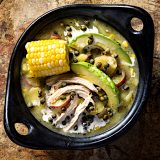Steep, fog-clad mountains encircling it, Bogotá can feel like a massive bowl, where green slopes pitch inward, turning brown and grey with urban sprawl. Cerro de Guadalupe and Monserrate dominate, but lesser Andean peaks—Pico del Águila, El Cable, El Chicó and the deliciously named Pan de Azúcar, or “sugar bread”—continue the hedge around Colombia’s capital.
Head north from the city and the green magnifies, farmland stretching out from both sides of roads often dirt and gravel. Traffic gives way to donkey- and horse-drawn carts hauling stainless steel tankards of raw milk from barns to the road’s edge to wait for the collection truck that will pool and process the proceeds of this dairy-rich region.
On this day, I’m in San Miguel de Sema, a lush and tiny hillside community several hours north of Bogotá. My guide—Mariana Velásquez, a food writer and Colombian food expert. Our destination—the ancient stone barn home of Ricardo Umaña, a retired businessman committed to restoring the natural forests and edible plantings of his many acres.
Our goal—a steaming bowl of his ajiáco, a soup so iconic many have come to consider it the archetype of Colombian cuisine.
“This is the anchor of Colombian food,” Velásquez, who learned to cook from her German and Lebanese descended grandmothers, explains while helping Umaña in the kitchen. “It’s one of the essential one-pot meals of Colombia.”
At its simplest, ajiáco is a chicken and potato soup. But that simplicity belies the complexity of its many layers of flavors and textures, nuances that are heightened even by the way it is served. Though most of the ingredients are cooked together, they are separated for serving, allowing each diner to assemble their bowl with more or less of each item as they see fit.
Briny capers spooned on at the table and sweet corn still on the cob offer brightening accents, while a finishing drizzle of cream lends richness. And always there is avocado. “You keep half an avocado next to you so you can scoop a bit with each bite of soup,” Velásquez says, noting that it’s never added directly to the soup. “Nobody likes a hot avocado.”
Ajiáco originated in Bogotá and is considered a celebratory meal, typically eaten for Sunday lunch. “It’s that one dish that’s served in all homes across the city,” says Velásquez. “It doesn’t matter the class or neighborhood.”
Most interesting is the way cooks use potatoes in ajiáco, for despite the chicken and corn, the potatoes are the star. The soup traditionally includes three varieties, and each has a different role. Pastusa, a yellow, starchy variety, is added first so it breaks down to create the soup’s creamy base. Next are criollas, which add a flavorful sweetness. Then finally sabaneras, a purple variety that retains its pleasantly firm texture even with cooking.
“Potatoes are so important to the diet of Colombia and especially the Andes,” says Umaña. “In Colombia, we have 750 varieties. For ajiáco, we only use three, thank God!”
The soup simmers while we walk Umaña’s property, dodging wayward geese, sheep and dozens of hummingbirds as we go. By the time we return, the ajiáco is ready to be divided up. Chicken and potatoes in one bowl, corn in another, the cream, capers and avocado at the ready. The result is an explosion of flavor, briny, sweet, savory and rich all at once. Tender, meaty, crunchy and creamy. Every bite is different. Every bite keeps your attention.
And I have to agree with Velásquez. The avocado is essential. And it definitely belongs on the side. Nobody likes a hot avocado.




